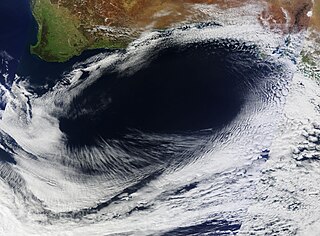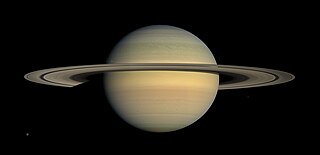
A ring system is a disc or ring orbiting an astronomical object that is composed of solid material such as dust and moonlets, and is a common component of satellite systems around giant planets. A ring system around a planet is also known as a planetary ring system.

Uranus is the seventh planet from the Sun. It has the third-largest planetary radius and fourth-largest planetary mass in the Solar System. Uranus is similar in composition to Neptune, and both have bulk chemical compositions which differ from that of the larger gas giants Jupiter and Saturn. For this reason, scientists often classify Uranus and Neptune as "ice giants" to distinguish them from the gas giants. Uranus' atmosphere is similar to Jupiter's and Saturn's in its primary composition of hydrogen and helium, but it contains more "ices" such as water, ammonia, and methane, along with traces of other hydrocarbons. It is the coldest planetary atmosphere in the Solar System, with a minimum temperature of 49 K, and has a complex, layered cloud structure with water thought to make up the lowest clouds and methane the uppermost layer of clouds. The interior of Uranus is mainly composed of ices and rock.

Rhea is the second-largest moon of Saturn and the ninth-largest moon in the Solar System. It is the second smallest body in the Solar System for which precise measurements have confirmed a shape consistent with hydrostatic equilibrium, after dwarf planet Ceres. It was discovered in 1672 by Giovanni Domenico Cassini.

Helene ( HEL-ə-nee; Greek: Ἑλένη) is a moon of Saturn. It was discovered by Pierre Laques and Jean Lecacheux in 1980 from ground-based observations at Pic du Midi Observatory, and was designated S/1980 S 6. In 1988 it was officially named after Helen of Troy, who was the granddaughter of Cronus (Saturn) in Greek mythology. Helene is also designated Saturn XII (12), which it was given in 1982, and Dione B, because it is co-orbital with Dione and located in its leading Lagrangian point (L4). It is one of four known trojan moons.

Tethys is a mid-sized moon of Saturn about 1,060 km (660 mi) across. It was discovered by G. D. Cassini in 1684 and is named after the titan Tethys of Greek mythology.
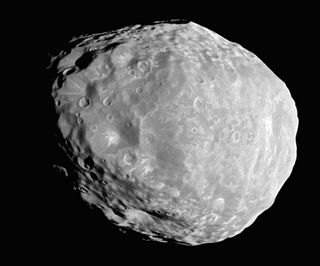
Janus is an inner satellite of Saturn. It is also known as Saturn X. It is named after the mythological Janus.

Epimetheus is an inner satellite of Saturn. It is also known as Saturn XI. It is named after the mythological Epimetheus, brother of Prometheus.

Himalia is the largest irregular satellite of Jupiter. It is the sixth largest Jovian satellite overall in size, and only the four Galilean moons of Jupiter have greater mass. It was discovered by Charles Dillon Perrine at the Lick Observatory on 3 December 1904 and is named after the nymph Himalia, who bore three sons of Zeus. It is one of the largest planetary moons in the Solar System not imaged in detail, and the largest not including the moons of Neptune and several trans-Neptunian objects, particularly Dysnomia, the moon of Eris.

Enceladus is the sixth-largest moon of Saturn. It is about 500 kilometers (310 mi) in diameter, about a tenth of that of Saturn's largest moon, Titan. Enceladus is mostly covered by fresh, clean ice, making it one of the most reflective bodies of the Solar System. Consequently, its surface temperature at noon only reaches −198 °C (−324 °F), far colder than a light-absorbing body would be. Despite its small size, Enceladus has a wide range of surface features, ranging from old, heavily cratered regions to young, tectonically deformed terrains.

Prometheus is an inner satellite of Saturn. It was discovered in 1980 from photos taken by the Voyager 1 probe, and was provisionally designated S/1980 S 27.

The moons of Saturn are numerous and diverse, ranging from tiny moonlets less than 1 kilometer across to the enormous Titan, which is larger than the planet Mercury. Saturn has 62 moons with confirmed orbits, 53 of which have names and only 13 of which have diameters larger than 50 kilometers, as well as dense rings with complex orbital motions of their own. Seven Saturnian moons are large enough to be ellipsoidal in shape, yet only two of those, Titan and Rhea, are currently in hydrostatic equilibrium. Particularly notable among Saturn's moons are Titan, the second-largest moon in the Solar System, with a nitrogen-rich Earth-like atmosphere and a landscape featuring dry river networks and hydrocarbon lakes found nowhere else in the solar system; and Enceladus since its chemical composition is similar to that of comets. In particular, Enceladus emits jets of gas and dust, which could indicate the presence of liquid water under its south pole region, and may have a global ocean below its surface.
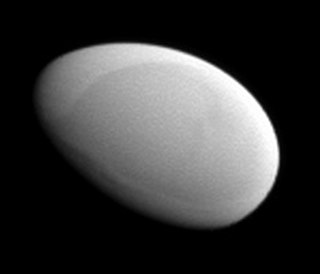
Methone is a very small natural satellite of Saturn orbiting between the orbits of Mimas and Enceladus. It was discovered in 2004, and in 2012 was imaged more closely by the Cassini orbiter probe.
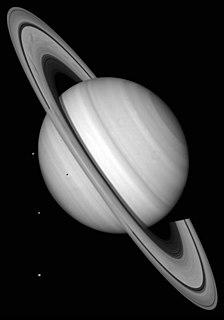
The rings of Saturn are the most extensive ring system of any planet in the Solar System. They consist of countless small particles, ranging from μm to m in size, that orbit about Saturn. The ring particles are made almost entirely of water ice, with a trace component of rocky material. There is still no consensus as to their mechanism of formation. Although theoretical models indicated that the rings were likely to have formed early in the Solar System's history, new data from Cassini suggest they formed relatively late.

The planet Jupiter has a system of rings known as the rings of Jupiter or the Jovian ring system. It was the third ring system to be discovered in the Solar System, after those of Saturn and Uranus. It was first observed in 1979 by the Voyager 1 space probe and thoroughly investigated in the 1990s by the Galileo orbiter. It has also been observed by the Hubble Space Telescope and from Earth for several years. Ground-based observation of the rings requires the largest available telescopes.

The magnetosphere of Saturn is the cavity created in the flow of the solar wind by the planet's internally generated magnetic field. Discovered in 1979 by the Pioneer 11 spacecraft, Saturn's magnetosphere is the second largest of any planet in the Solar System after Jupiter. The magnetopause, the boundary between Saturn's magnetosphere and the solar wind, is located at a distance of about 20 Saturn radii from the planet's center, while its magnetotail stretches hundreds of Saturn radii behind it.

The climate of Uranus is heavily influenced by both its lack of internal heat, which limits atmospheric activity, and by its extreme axial tilt, which induces intense seasonal variation. Uranus' atmosphere is remarkably bland in comparison to the other gas giants which it otherwise closely resembles. When Voyager 2 flew by Uranus in 1986, it observed a total of ten cloud features across the entire planet. Later observations from the ground or by the Hubble Space Telescope made in the 1990s and the 2000s revealed bright clouds in the northern (winter) hemisphere. In 2006 a dark spot similar to the Great Dark Spot on Neptune was detected.
Philip D. Nicholson is an Australian-born professor of astronomy at Cornell University in the Astronomy department specialising in Planetary Sciences. He has been editor-in-chief of the journal Icarus since 1998.
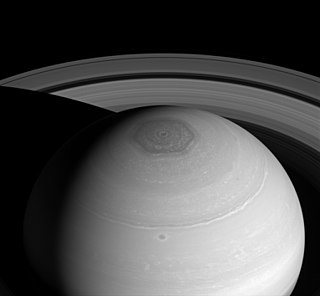
Saturn's hexagon is a persisting hexagonal cloud pattern around the north pole of Saturn, located at about 78°N. The sides of the hexagon are about 14,500 km (9,000 mi) long, which is more than the diameter of Earth. The hexagon may be a bit greater than 29,000 km (18,000 mi) wide, may be 300 km (190 mi) high, and may be a jet stream made of atmospheric gases moving at 320 km/h (200 mph). It rotates with a period of 10h 39m 24s, the same period as Saturn's radio emissions from its interior. The hexagon does not shift in longitude like other clouds in the visible atmosphere.
